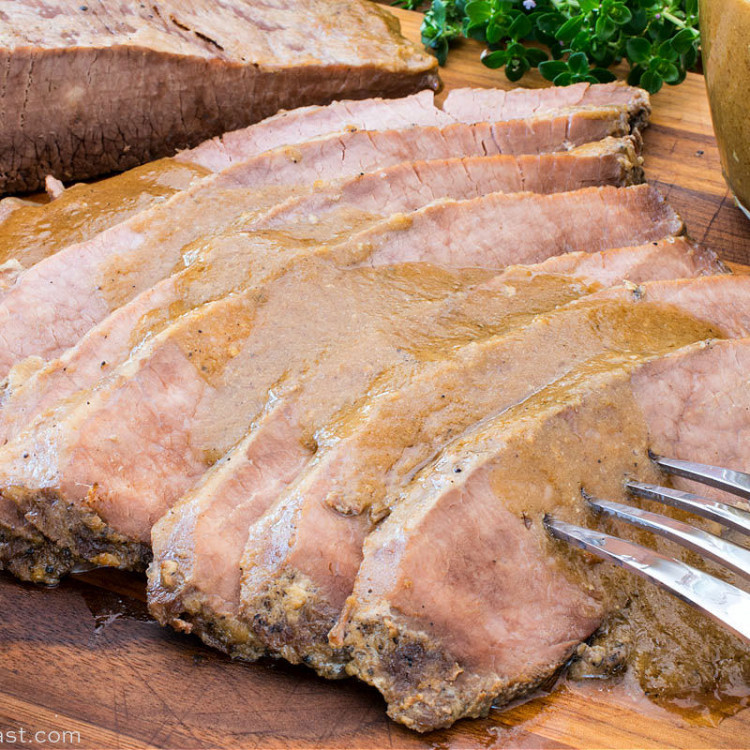We love seeing what you made! Tag us on Instagram at @afamilyfeast or hashtag #afamilyfeast so we can see your creations!

Oven-Roasted Horseradish Beef Brisket
Ingredients
Instructions
Cut off any large thick visible sections of fat but leave some still attached. Our roast was not that fatty so we did not remove any.
Place a rack over a sheet tray lined with foil and lay the brisket over it and sprinkle both sides with the salt and pepper ending with the fat facing up.
Refrigerate for 18-24 hours (24 hours is better) uncovered in the refrigerator.
4-5 hours before serving, preheat the oven to 325 degrees F.
Brush off the surface salt and pepper. (It did its job by infusing salt and pepper into the meat. It’s fine to leave a little on the surface.)
Pour the beef stock into the bottom of an appropriately sized roasting pan large enough to accommodate the roast lying flat.
In a medium to large saute pan, melt the butter over medium heat and add the onions and cook for five minutes.
Add the garlic and cook for one more minute.
Add the Worcestershire sauce, fresh thyme sprigs and bay leaves and cook for one more minute then remove from heat and set aside.
In a small bowl mix mayonnaise and horseradish.
Remove the roast from the rack and smear the mayonnaise mixture all over the roast with most of it over the top fat side and lay the roast into the roasting pan over the beef stock.
Pour the contents of the saute pan over the top of the beef and spread to the edges.
Cover tightly with foil (always place shiny side of foil towards the food)** and place in the oven for 90 minutes.
Without opening the oven door, lower temperature to 250 degrees F and continue to cook for two more hours (less if your roast is smaller).
Pull off the foil and test for doneness. It should start to fall apart as you lift it. Slice off a little sliver against the grain and check for doneness. If more time is needed, seal back with foil and cook for up to 30 minutes longer.
Lift the cooked roast and wipe the solids off the top and scrape back into the pan.
Place the roast on a platter to rest and loosely cover with foil. We used two large spatulas to lift it out so it wouldn’t fall apart as we lifted.
Ladle out as much of the fat that has floated to the top as possible and discard along with the bay leaves.
Place the pan on the stove and boil down to about two cups.
Pour the reduced liquid into a blender and puree or use an immersion blender.
Pour this liquid into a sieve or strainer and use the back of a spoon to press it through the strainer. Discard the mash left in the strainer and use the liquid to serve with the beef. It should be slightly thick.
Using a sharp long slicer knife, trim off any large pieces of fat then slice the brisket into thick slices against the grain and serve with the sauce.
Last Step! Please leave a review and rating letting us know how you liked this recipe! This helps our business thrive & continue providing free recipes.
Notes
*Brisket of beef typically comes as a full brisket which is usually about six pounds or in smaller three-pound pre-wrapped packages. If you are following this recipe with a smaller brisket, cut all other ingredients in half but follow the same method, reducing the oven time slightly to accommodate the smaller roast.
**Aluminum foil is manufactured with a shiny side and a dull side due to the manufacturing process. However in the kitchen, the shiny side reflects heat and the dull side absorbs heat. If you are covering a pan with food in it to bake, the shiny side should face the food and the dull side face up. If you are lining a pan with foil and plan on placing food on it to bake, the shiny side should face up, again to reflect heat up towards the food.